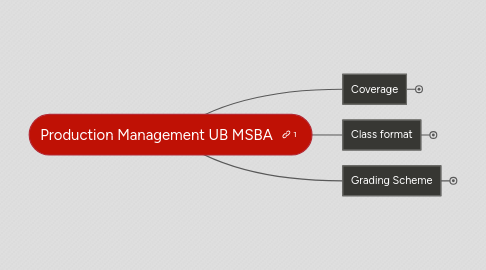
1. Coverage
1.1. Operations Analysis
1.1.1. Tools
1.1.1.1. Critical path method
1.1.1.2. Statistical process control
1.1.1.3. Forecasting
1.1.1.4. Inventory control
1.1.1.5. Queueing theory
1.1.2. Processes
1.1.2.1. Process types
1.1.2.2. Process & life cycles
1.1.2.3. Services
1.1.2.3.1. Food
1.1.2.3.2. Health care
1.2. Coordination & Planning
1.2.1. BPR
1.2.2. Theory of constraints
1.2.3. MRP to ERP
1.2.4. Cellular manufacturing
1.2.5. JIT
1.3. Project Management
1.3.1. Product launch
1.3.2. Critical Path method (tools)
1.3.3. Risk management
1.3.4. Competitive Project management
1.3.5. Design Structure Matrix
1.4. Quality Management
1.4.1. Deming
1.4.2. Juran
1.4.3. Cosby
1.4.4. 6-sigma
1.4.5. Robust design
1.4.6. SPC (tools)
1.5. Logistics & Supply Chain Management
1.5.1. Rapid response
1.5.2. Customer service
1.5.3. Inventory positioning
1.5.4. Logistics system design
1.5.5. Coordination
1.5.6. Core competencies
2. Class format
2.1. Dialogues & Discussion
2.2. Preparation & Participation
2.3. Addressing Focus Questions
3. Grading Scheme
3.1. Class participation 10%
3.1.1. Contextual
3.1.1.1. Willingness to participate and attentive to discussion
3.1.2. Innovative
3.1.2.1. There is willingness to test new ideas and comments are not confrontational.
3.1.3. Insightful
3.1.3.1. Comments are appropriate and indicates insightful analysis of case data
3.1.4. Relevant
3.1.4.1. Comments are relevant to current discussion and linked to comments of others
3.1.5. Supported
3.1.5.1. Comments clarify important aspects of earlier ideas and lead to clearer statement of relevant concepts and issues
3.2. Assigned Topic 50%
3.2.1. Quality analysis
3.2.1.1. Major issues are addressed
3.2.1.2. Relevant tools are used properly
3.2.1.3. Assumptions for analysis are stated clearly
3.2.1.4. Causes of the problems are identified in the analysis
3.2.2. Exhibits
3.2.2.1. Analyses in the exhibits are done correctly
3.2.2.2. Exhibits support and clarify key points
3.2.2.3. Not more than 7 exhibits
3.2.3. Recommendations
3.2.3.1. Criteria for selecting alternative recommendations are given
3.2.3.2. Criteria are appropriate
3.2.3.3. Plan of action is logical linked to the analysis
3.2.3.4. Plan of action is specific, complete and practical
3.2.3.5. Recommendations are likely to achieve intended results
3.2.4. Presentations
3.2.4.1. Report is not long, 2000 words max
3.2.4.2. Presentation is professionally done
3.2.4.3. Report is consistent and effectively sells its recommendations
3.3. CT Exercises 30%
3.3.1. Bring exam admission slip
3.3.2. Last meeting
3.3.3. Use 50 leaves bound notebook
3.3.4. Coverage (all focus questions not covered in the discussions)
